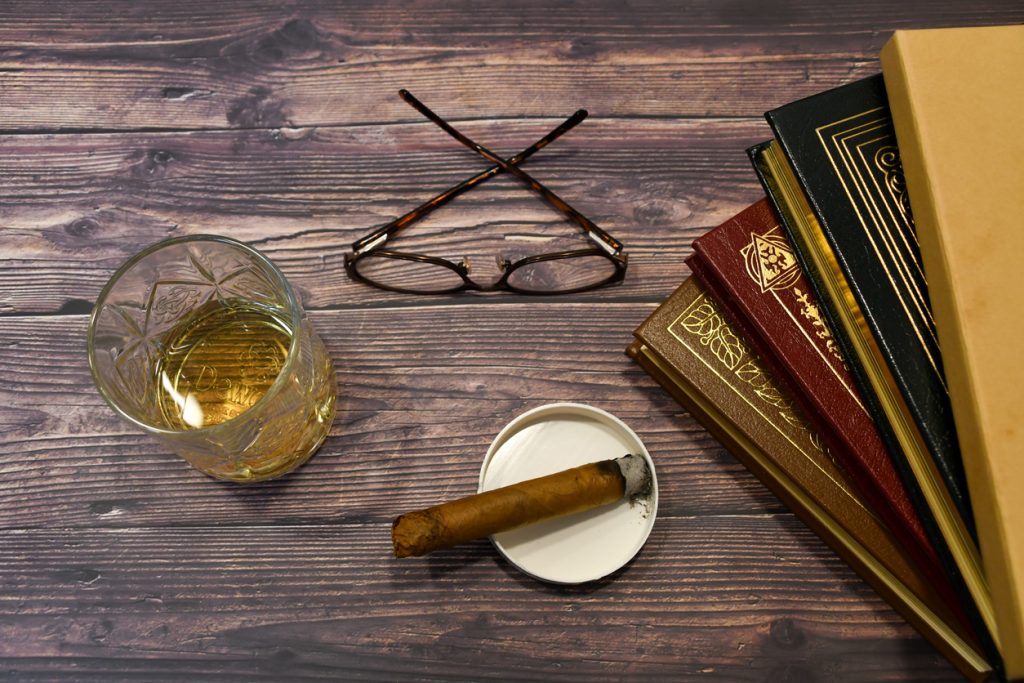Welcome to the fascinating world of cigar tasting! Whether you are a novice or a seasoned enthusiast, learning to develop your palate is essential for fully savoring the complexities of premium cigars. In this comprehensive guide, we will explore the art of cigar tasting, offering techniques and tips to help unlock the hidden flavors and aromas in every cigar you enjoy.
The Five Steps of Tasting Cigars
Cigar tasting is a straightforward process; however, the intricate part enters when you start learning about cigars, their origins, and how different manufacturers use the tobacco to make cigars.
1. Visual Examination: Inspect the cigar’s wrapper for imperfections; a well-rolled cigar should have a smooth appearance. We’ve covered this topic in a previous post (read it here). Check your cigar’s condition before lighting it. A well-maintained humidor preserves flavors and aromas by keeping cigars at the proper humidity level. Avoid lighting overly moist or dry cigars.
2. Sniffing the Foot: Smell the foot to preview the cigar’s aromas before lighting.
3. Lighting the Cigar: Light it evenly and avoid rushing this step—read more about the proper technique in our previous post on cigar preparation.
4. First Puffs: Gently puff and savor the initial flavors on your palate.
5. The ‘Retrohale’ Technique: Exhale smoke through your nose to perceive additional flavors and aromas.
With these steps in mind, we can look at other factors, such as preparing yourself for a tasting session. When everything is prepared and ready to light up, you can consider factors like cigar strength, the wrapper’s contribution to the taste, and the difference between smoke vs. aroma.
Preparing for the Cigar Tasting Experience
Create an ideal environment for tasting by finding a quiet and comfortable spot with minimal distractions. Adequate ventilation is essential to ensure you can smell all the aromas without interference from external sources or harsh smells within the room, like air fresheners and the like.
Complement your cigar with beverages like coffee, whiskey, or sparkling water to enhance the tasting journey. We’ll be covering various pairings in future posts—keep an eye out for them! The key is to choose a drink that won’t overpower the taste of the cigars. My personal choice is still (not sparkling) mineral water because it has a neutral taste.
Understanding the Basics of Cigar Tasting

Before diving into the tasting process, grasp the fundamentals of cigars and their meticulous craftsmanship. Hand-rolled with tobacco leaves from different regions, each cigar’s unique character depends on its wrapper, binder, and filler. Appreciating these components enhances your overall tasting experience.
When you delve into the world of cigars, several factors are worth exploring. First, the wrapper leaf affects how the cigar looks and contributes to its aroma. You’ll find a range of options, from mild Connecticut Shade to dark Maduro wrappers with various colors in between. Then, there are the filler tobaccos, carefully blended to create a complex and rich flavor experience for the smoker. The strength level is another aspect to consider, showing whether a cigar is mild, medium, or full-bodied. And, of course, the construction quality matters too – a well-made cigar with a good draw is essential for an enjoyable smoke.
Cigar tasting is all about discovering what sets each brand and blend apart. By engaging our senses of sight, smell, and taste, we can explore the unique components that make every cigar special. As you indulge in different brands and blends, your palate naturally refines, and you’ll learn to appreciate the subtle nuances with each smoke session. So, take your time, savor the experience, and let your senses guide this delightful journey of exploration.
Cigar Strength

Example of a cigar strength chart (source)
Cigars come in various shapes and sizes, ranging from the compact robusto vitolas measuring around five inches (12,7 cm) to the elongated giant Churchill vitolas measuring up to seven inches (17.8 cm) long. Although the size doesn’t always directly indicate the taste or strength level, as some small ring gauge cigars might surprise you with their strength, the shape can influence your smoking experience due to differences in airflow during puffing and combustion.
Understanding the different cigar shapes allows smokers to refine their palate while exploring new blends. Cigar appreciation goes beyond just blowing smoke rings or technical knowledge; it’s a journey of self-discovery as you experiment with different flavors over time, making it a unique and enriching hobby. So, if you’re seeking a delightful way to sharpen your aficionado skills while enjoying yourself, look no further than the art of cigar tasting.
Cigar Wrapper
Did you know the wrapper leaf is crucial and contributes to over sixty percent of the perceived taste? Wrappers are broadly classified into two categories: Natural and Maduro. Among the common Natural wrapper varietals are Connecticut Shade and Ecuador Connecticut, often used on smooth and mild cigars. On the other hand, Maduro wrappers tend to be darker and sweeter. These variations in wrapper types offer diverse flavor profiles to cater to the different preferences of cigar enthusiasts.
Cigar wrappers and their typical tasting notes
| Origin | Typical Taste Notes |
| Cameroon (harvested in Cameroon and the Central African Republic) | Coffee beans, nuts, and baking spices |
| Connecticut Broadleaf | Wrapper leaf has a dark appearance. Dark chocolate, molasses, espresso, and sweet spices |
| Connecticut Shade | The wrapper leaf has a golden appearance. Mellow and rich notes of cedar, cashews, almonds, and blonde roast coffee |
| Corojo | Grown from Cuban tobacco seed in Central America. Prominent notes of cayenne pepper and wood |
| Dominican | Very rare. A blend of spicy, creamy, and complex flavors |
| Ecuadorian Connecticut | Connecticut seeds that are grown in Ecuador. Notes of nuts, cedar, and white pepper |
| Ecuadorian Habano | Cuban-seed tobacco grown in Ecuador. Spicy and earthy notes combined with wood and leather |
| Ecuadorian Sumatra | Sumatran seed that is grown in Ecuador. Creamy. Rich. Hints of coffee beans and leather. |
| Nicaraguan | Commonly used on stronger cigars. Cocoa, baking spices, red pepper, and wood |
| San Andrés | San Andrés Valley, Mexico. Complex taste of almonds, cracked black pepper, and espresso. |
Smoke vs. Aroma
To understand cigar tasting comprehensively, it’s crucial to differentiate between a cigar’s aroma and smoke. The aroma, which can vary based on the wrapper (pointed out above), binder, filler, and country of origin, encompasses a wide range of scents, from woody and leathery to sweet and spicy. Taking your time while smoking and paying attention to the nuances of the scent profile will help you fully appreciate the aromas in a cigar. Take a big draw, hold the smoke in your mouth for a few seconds, and exhale slowly to discern different notes within the aroma.

Additionally, learning about how different types of tobacco burn can refine your palate for cigars. Some tobaccos burn hotter than others, influencing the flavor. Being mindful of temperature changes during smoking is essential. Various tobaccos also produce varying amounts of smoke, affecting the taste; fuller-bodied cigars tend to generate thicker clouds, while milder ones may be more subtle in smoke production. Understanding these aspects beforehand can help you grasp why certain cigars are more enjoyable based solely on their flavor profiles.
Cigar aficionados assess cigars in unique ways beyond just tasting them, such as examining construction quality and ash production. These factors indicate how well-crafted a cigar might be. Paying attention to firmness and drawing resistance provides insights into the craftsmanship of the product. On the other hand, inconsistencies in construction could suggest manufacturing errors, leading to lower-quality results overall. We’ll cover some more tips lower down.
Naming Flavors and Aromas
With the basics behind us, what fun would it be to talk about tasting cigars if we don’t help you to identify what you’re tasting? Tasting cigars is a personal journey; each individual may perceive different flavors and aromas. Typical profiles include earthiness, sweetness, spice, nuttiness, and notes of coffee or chocolate. Take your time to explore these flavors and how they evolve.
Learn the Language of Taste
Cigar tasting is an art; like any skill, it comes with its language. If you’re aspiring to be a cigar connoisseur, learning the jargon of cigar smoking is essential. It lets you grasp the subtleties of different cigars, from wrappers to binders to fillers. To kickstart your journey toward becoming a cigar aficionado, here are some key terms that every aspiring smoker should know:
- Strength refers to the intensity of flavor in a cigar. There are three main categories: mild-bodied, medium-bodied, and full-bodied, each with its range of strength levels. For instance, a mild-bodied cigar will be light and smooth, while a full-bodied one will be more robust, with more intense notes in its taste profile.
- Flavor profiles encompass all aspects of a cigar’s taste experience, from woody tones to sweet hints and spicy undertones. Depending on their origin and blending methods, these flavors can vary significantly between brands and even within them. The flavor notes typically arise from various ingredients like blended tobacco or the aging process in the humidor. Understanding these aspects can supply valuable insights into why certain cigars have unique tastes compared to others in their class.
One of the most challenging parts of cigar tasting is naming the flavors and aromas. Here are some of the most common flavors and aromas you may encounter (collated from this source):
| Taste Term | What you can expect |
| Earthy | Wood, mushroom, soil |
| Woody | Wood flavors like cedar, oak, and maple (think of maple-smoked meats) |
| Spicy | Ginger, nutmeg, cinnamon, nutmeg, and other kinds of spices |
| Sweet | Honey, caramel, chocolate, sugar, (burnt) sugar, vanilla |
| Fruity | Plumbs, cherries, apples, oranges, or any other fruit |
| Nutty | Hazelnuts, walnuts, almonds, cashews, pecans, etc. |
| Floral | Rose, lavender, jasmine, honeysuckle, etc. Some of these can also fall under sweet |
| Coffee | Robust and bold coffee flavors like espresso, even slightly bitter |
| Leather | Suede, leather, etc. |
| Tobacco | Tobacco tastes without any additions |
These are just a few examples of the flavors and aromas you may encounter while cigar tasting. As you become more familiar with the process, you may find that you can detect even more nuanced flavors and aromas.
Developing your palate takes practice and patience. Experiment with different blends, wrappers, and sizes to expand your flavor repertoire. Keep a tasting journal to record impressions and refine your senses.
Remember those color wheels our teachers used to teach us about colors? Well, in the world of cigars, they are a helpful tool everyone uses – from smokers to tobacconists to blenders – it supplies a common vocabulary to describe what you’re tasting. As your palate develops over time, you might start noticing different nuances and hints when you light up a cigar. Here’s a full tutorial and a downloadable flavor wheel you can explore.

Proper Tasting Etiquette
Observe proper etiquette during cigar tasting. Respect others’ space, refrain from flicking ashes, and avoid loud conversations. Cigar smoking is a social activity meant to be enjoyed in harmony. Avoid bombarding other members with your opinions unless you never want to receive an invitation again… When asked for your opinion by a friend or your tasting host, be honest but don’t go overboard and say things like ‘it tasted like twigs’ or ‘the cigar was downright awful.’ Take the time to think about what you are tasting and if the need arises, make some mental notes or ask for a pen and paper to jot down notes.
Never, and I repeat, never dismiss a cigar based on its country of origin, label, or wrapper. This is a surefire sign of snobbery. Yes, we all know that person who likes to brag about the rare or expensive cigar they tasted while traveling through some obscure place. Do. Not. Be. That. Person. Cigar tasting aims to train your senses and develop your palate.
General Tips
It is a good idea to keep a tasting diary where you can write down your observations about a cigar. For example, you can focus on factors important to you – brand, shape, wrapper color, ring gauge size, the amount of smoke the cigar produces, and thickness of the smoke. Other factors include the first taste you identify when lighting up compared to a few minutes later. We’ll post about hosting a cigar-tasting event soon, so keep an eye out for that!
Conclusion
Embark on the journey of cigar tasting and palate development, connecting to a rich tradition and culture. With practice and curiosity, you’ll uncover delightful flavors and aromas within each cigar. Be mindful, share the enjoyment with fellow enthusiasts, and savor the art of cigar tasting. Happy smoking and happy tasting!

